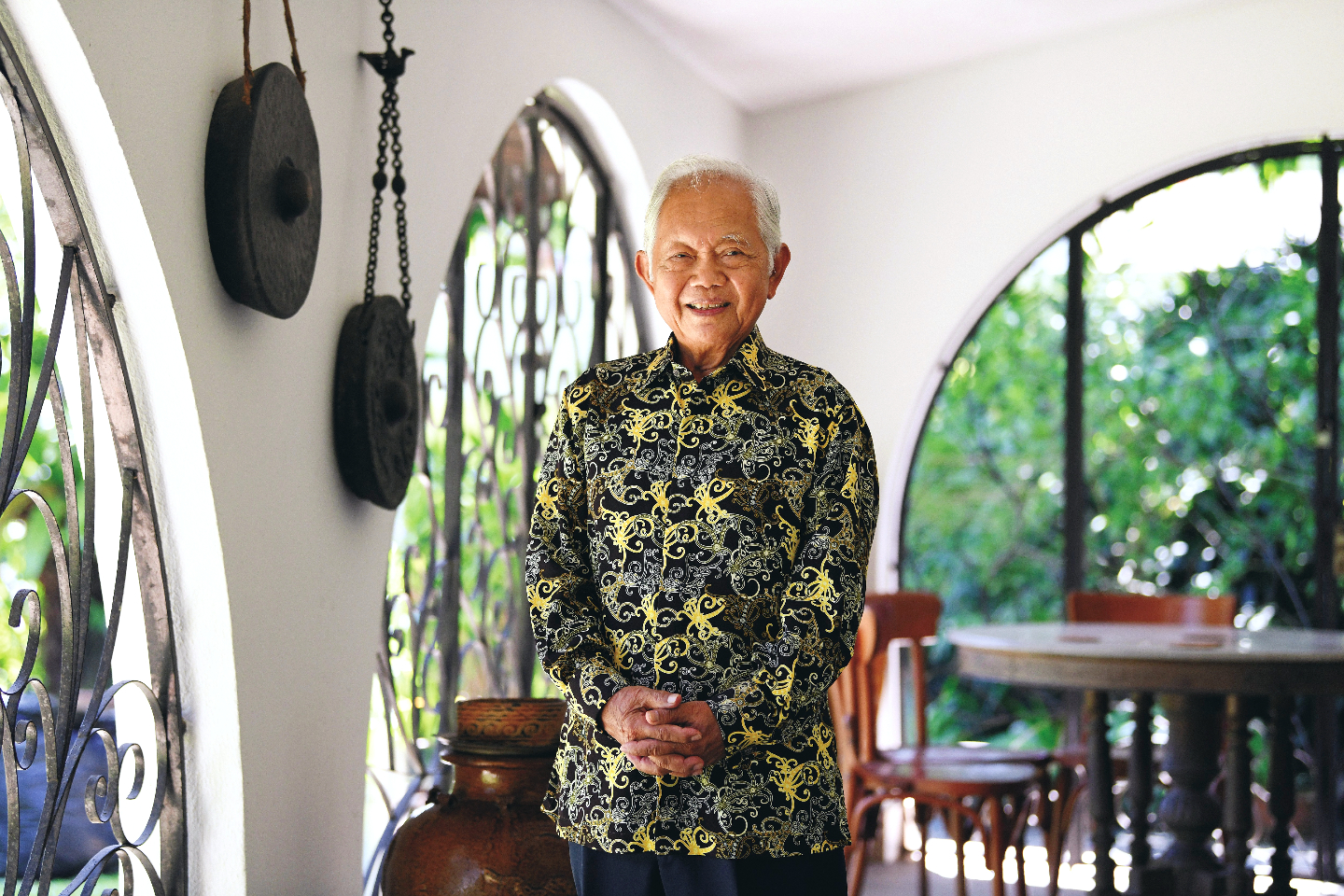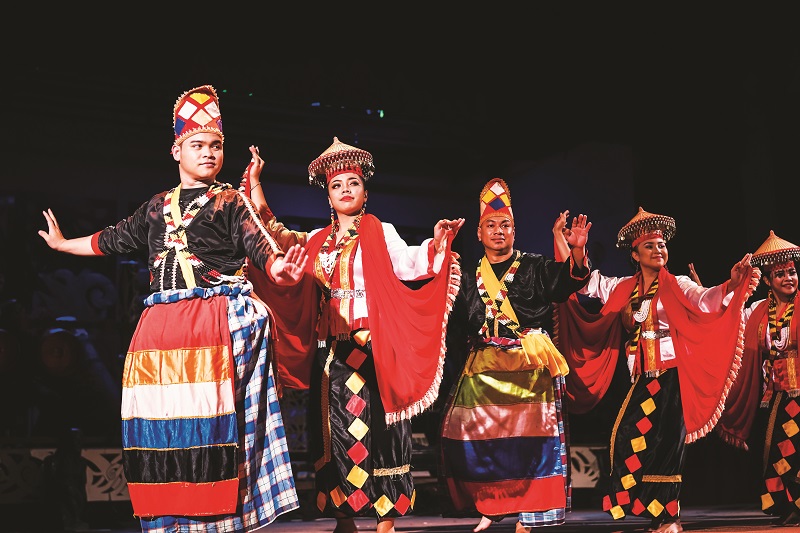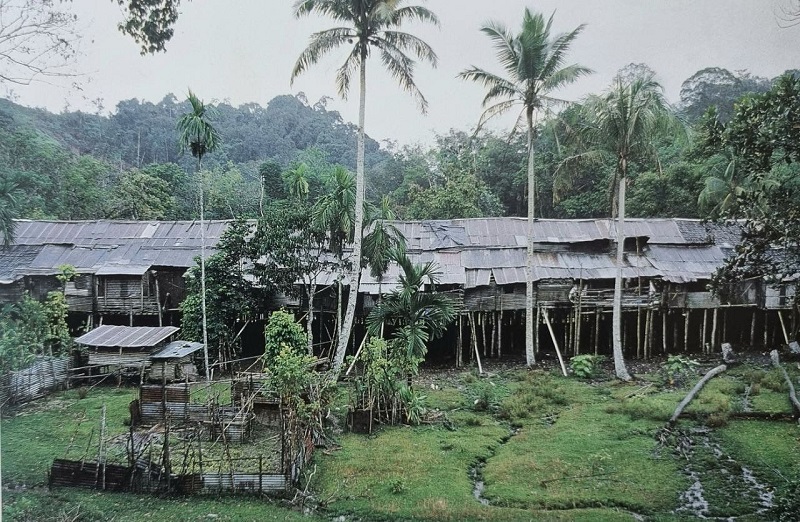
Leo: It was designed to inspire people not just to learn about Sarawak, but also get them to visit — and not just the main cities, but smaller towns a little farther out as well (Photo: Low Yen Yeing/ The Edge Malaysia)
Tan Sri Leo Moggie’s home in Damansara Heights, Kuala Lumpur, is like a mini museum dedicated to all things Sarawakian. Between him and his wife, Elizabeth, there are cabinets filled with antique jewellery, a generous amount of artwork and antiquities, as well as wall-to-wall bookshelves filled with thick tomes on the subject, with many more from his collection now sitting in the library of a local university. Life members of Badan Warisan Malaysia (BWM), the couple have channelled their immense knowledge and understanding of Sarawakian culture into a six-part educational webinar series launched in conjunction with World Heritage Day.
Titled Spotlight on Sarawak — although, we far prefer its nickname of #TokSarawak — it will cover a wide range of topics, from the architectural history of longhouses, ancient forts of Sarawak and origins of the Baram Regatta to Sarawakian textiles, cuisine as well as cultural, historical and natural heritage. Scheduled to kick off on April 21, the series will feature an impressive line-up of speakers such as Tun Jugah Foundation research director Dr Robert Menua Saleh; the Culinary Heritage and Arts Society Sarawak chairperson Datin Dona Drury Wee; and Unimas Institute of Borneo Studies associate research fellow Dr Valerie Mashman.
“Badan Warisan has been in existence for some time and is known for its purpose of getting people interested in conservation and heritage, particularly the young,” Leo begins. “This year, for International Heritage Day, Badan Warisan has decided that spotlighting Sarawak would be a useful initiative.
“There are a few reasons for this. First, Sarawak has its own heritage trust group and it has been very active. So, it is great that Badan Warisan in KL is giving it the recognition it deserves. Second, Sarawak has a multicultural background of its own, quite [different from] what is seen in Semenanjung Malaysia, and it is not well recognised by all Malaysians. Particularly when one speaks of indigenous communities, their heritage and culture are not well appreciated or recognised throughout the country.”
150998026_l.jpg

Opting for a webinar format instead of an in-person event is based on precedent. Since the start of the pandemic, BWM’s regular talks have been held online, while its digital platform — most notably, its gift shop — saw growing interest among both members and non-members. Since the team had become accustomed to working in this way, a webinar format seemed like a good idea. Most importantly, this format serves the needs of those who are not based in the Klang Valley but would still like to attend. The webinar is organised in partnership with the Sarawak-based Petra Energy Bhd and supported by Creador Foundation, Cahya Mata Sarawak Bhd, COPE Private Equity Sdn Bhd and Centriq PR Sdn Bhd, whose contributions will support BWM’s educational efforts in the fields of conservation.
The first episode of #TokSarawak is helmed by Tun Jugah Foundation’s Robert and Leo, and is centred on the significance of traditional longhouses, as “virtually all the indigenous ethnic groups in Sarawak live in them. Therefore, we thought making longhouses a major topic would project not just their physical structure but also the cultural heritage of communities who live in these community dwellings”.
Leo passes us a book mid-conversation; From Longhouse to Capital: Recollections was published in 2018. Although he maintains that it is about his personal memories of living in a longhouse and not a historical account by any means, it provides valuable insights into this unique cultural icon of the orang asal of Borneo.
The first episode will be held on April 21 at 5pm — a timing that accommodates viewers from Europe to join in as well — and the final one is scheduled for July 7. The breadth of the topics is vast indeed, with each session designed to be informative, enlightening and entertaining. Admission is free.
“The idea was to combine serious content with current obsessions like food — we eat too much sometimes,” he smiles, when asked how the six episodes of the webinar were initially mapped out. “It was designed to inspire people not just to learn about Sarawak, but also get them to visit — and not just the main cities, but smaller towns a little farther out as well. Kuching is undergoing a lot of development and becoming a heritage site to be reckoned with, alongside smaller destinations like Sri Aman and Miri. There is so much to explore and understand about Sarawak, and getting people there is also part of our aim with the series.”
One of the topics covered by the webinar is the importance of cherishing our cultural heritage and how we can collectively save it from disappearing with the times — something that is especially relevant to oral traditions that are passed down from generation to generation. Education is key, which remains the main objectives of #TokSarawak.
“Heritage is what we inherit from our predecessors, to appreciate and respect in the present and safeguard for future generations. Here, as in many countries, urbanisation and a focus on new structures put physical heritage buildings at risk of being forgotten. We need to be quite conscious so that the push of urbanisation does not neglect structures with valuable historical significance. Modern life also means that certain traditional practices are no more relevant, but that does not mean they should be forgotten. Some of these practices must be properly understood to be truly appreciated.”
Leo goes back to the example of the longhouse to illustrate his point. “In a longhouse, families have their respective living spaces for privacy, but also have access to a community hall, called a ruai, to get together. It’s a village, a community that cares for its various members and encourages support and mutually beneficial living. There is much to learn from these practices, but it is up to the younger generation to work out how they can best apply them to modern life.”
278188962_5268725529845282_3858771057700024854_n.jpg

Sipping his coffee — a delicious Acehnese highland blend — thoughtfully, he adds, “Around the world, it has been observed how heritage can contribute to economic and social development through tourism, arts and crafts, enhancement of culture, and re-energising communities and places.
“This webinar highlights only part of the cultural and built heritage that exists in Sarawak, which is an important aspect of our national identity. It must not die out; it must not be forgotten. We must recognise the cultures that are different from us, and that might just change the way we think of doing things at a national level.”
Episode breakdown
April 21: The Heritage of Sarawak’s Traditional Longhouse
Explore key insights from Tun Jugah Foundation’s research and studies of two aspects of traditional longhouses — architectural significance and village society — on how the ethnic groups lived, from the nature of their leadership and hill rice farming to festivals, culture and crafts. Also discussed is how this communal dwelling has been modernised for current times while retaining its important cultural values.
April 28: The Baram Regatta
The Baram Regatta of 1899, with the Great Peacemaking at Marudi, is an iconic moment in Sarawakian history because of the sheer magnitude of the spectacle captured by photographs and visiting eyewitnesses. Although Charles Hose appeared to be the architect of peacemaking, a closer look at events from a Sarawakian perspective reveals that that peace was achieved through the efforts of local leaders. The second part of the talk will deal with the legacy of the regatta through contemporary means, and why these memories contribute to cultural continuity.
May 19: Sarawak’s Exotic Food Heritage
Discover the state’s unique indigenous ingredients and culinary traditions that form an integral part of Sarawakian heritage, connecting different tribes, cultures and communities. Learn about the heritage rice and the variety of tuak (rice wine) made from it and the taboos and beliefs practised in its brewing. If smells and tastes could be transported through the internet, expect your taste buds to be tickled as you are introduced to delicacies such as tepus (red gingerwort), terong assam (sour eggplant), assam payak (sour snake fruit) and a multitude of edible ferns.
June 9: The Forts of Sarawak
The Brooke dynasty has long relinquished its reign over Sarawak but its influence and presence during the early formative years of the Land of the Hornbills is still evident today. For instance, monuments and buildings of varying importance grew in number during the Brooke administration, as did the population of the local communities. These structures, inlcuding forts, form an impressive part of the physical landscape of Sarawak today, and have become popular tourist attractions. The Brooke family built forts across Sarawak — more than 20 to be exact — and this session examines their importance then and their relevance now.
June 23: Traditional Textiles and Costumes
The earliest evidence of textiles in Sarawak are fragments associated with burials recovered from Niah Cave, where prehistoric humans lived 40,000 years ago. And the earliest material known to be used for clothing was tree bark, which cuts across the indigenous communities in Sarawak. This webinar session explores the history and enduring popularity of other local textiles such as pua kumbu, songket and keringkam. Despite the differences in social backgrounds and cultural environment, these textiles unite the different ethnicities because of their uniqueness and history, on top of the beauty of their creation.
July 7: Sarawak’s Endangered Heritage
Through examples and extrapolation, this talk will discuss the status of heritage management in Sarawak, highlighting present and future threats. There will be an outline of the dangers ahead if action is not taken to preserve these assets and the importance and collective responsibility to defend and ensure the conservation and safeguarding of Sarawak’s heritage. Only when the government, private sector and local community work together can the nation achieve sustainable heritage management.
Register for BWM's Spotlight on Sarawak talks here.
This article first appeared on Apr 18, 2022 in The Edge Malaysia.


